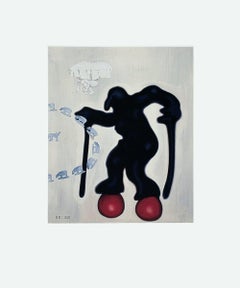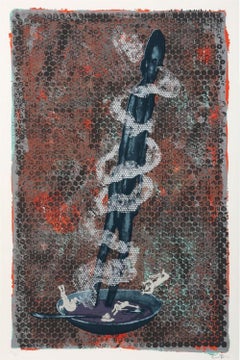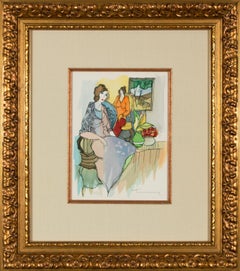Jörg Immendorf Art
German, 1945-2007
Jorg Immendorff was a German painter, sculptor, stage designer and art professor. He was a member of the art movement Neue Wilde. Immendorff often worked in "grand cycles of paintings" that often lasted years at a time and were political in nature. Notable cycles include LIDL, Maoist Paintings, Cafe Deutschland , and The Rake's Progress.
The first body of work that Immendorff gave a name to were his LIDL paintings, sculptures, performances, and documents, that he executed during 1968-1970. The name, "LIDL" was inspired by the sound of a child's rattle makes and much of his work from this period included the iconography of new beginnings and innocence. LIDL is comparable to Dadaist but unlike the Dadist movement it never became an established group but rather consisted of a variety of artists (including James Lee Byars, Marcel Broodthaers, Nam June Paik, and Joseph Beuys) participating in actions and activities.to
1
2
2
2
2000 Jorg Immendorf 'Untitled (Hui Gui)'
By Jörg Immendorf
Located in Brooklyn, NY
Paper Size: 23.5 x 19.5 inches ( 59.69 x 49.53 cm )
Image Size: 14.25 x 11.75 inches ( 36.195 x 29.845 cm )
Framed: No
Condition: A-: Near Mint, very light signs of handling
Ad...
Category
Early 2000s Contemporary Jörg Immendorf Art
Materials
Offset
$240 Sale Price
60% Off
Large Silkscreen Serigraph Neo Figurative Expressionist Print Jorg Immendorff
By Jörg Immendorf
Located in Surfside, FL
Jorg Immendorff (German, 1945-2007)
Untitled, Germany, 2006
serigraph
hand signed and dated lower right margin, numbered 20/27 lower left
framed
74.5 x 48.75 inches (sight).
82.25 x 55.5 inches (frame).
This work is number 20 from the edition of 27.
Provenance: T. Kreuzer Gallery, Cologne, Friedman Benda Gallery, New York City
Jörg Immendorff (1945–2007) was a German painter, sculptor, stage designer and art professor. He was a member of the art movement Neue Wilde. He worked as a painter, sculpture and print maker in steel, bronze, oil painting, lithography etching and serigraphy.
Immendorff was born in Bleckede, Lower Saxony, near Lüneburg on the west bank of the Elbe. He attended the boarding School Ernst-Kalkuhl Gymnasium as a student. At the age of sixteen he had his first exhibition in a jazz hall cellar in Bonn.
Beginning in 1963, Immendorff studied at the Art Academy in Düsseldorf (Kunstakademie Düsseldorf). Initially he studied for three terms with the theater designer Teo Otto. After Otto threw him out of his class for refusing to let one of his paintings serve as stage-set decoration, Immendorff was accepted as a student by Joseph Beuys. The academy expelled him because of some of his (left-wing) political activities and neo-dada actions.
From 1969 to 1980, Immendorff worked as an art teacher at a public school, and then as a free artist, holding visiting professorships all over Europe. In 1989, he became professor at the Städelschule in Frankfurt am Main and in 1996 he became professor at the Art Academy in Düsseldorf—the same school that had dismissed him decades earlier as a student.
Jörg Immendorff often worked in "grand cycles of paintings" that often lasted years at a time and were political in nature. Notable cycles include LIDL, Maoist Paintings, Cafè Deutschland , and The Rake's Progress. The first body of work that Immendorff gave a name to were his LIDL paintings, sculptures, performances, and documents, that he executed during 1968-1970. The name, "LIDL" was inspired by the sound of a child's rattle makes and much of his work from this period included the iconography of new beginnings and innocence. LIDL is comparable to Dadaist but unlike the Dada movement it never became an established group but rather consisted of a variety of artists (including James Lee Byars, Marcel Broodthaers, Nam June Paik, and Joseph Beuys) participating in actions and activities.
In January 1968 he appeared in front of the West German Parliament in Bonn with a wood block labeled “Lidl” tethered to his ankle and painted in the colors of the German flag; he was subsequently arrested for defaming the flag.
Best known is his Cafe Deutschland series of sixteen large paintings (1977–1984) that were inspired by Renato Guttuso Caffè Greco; in these crowded colorful pictures, Immendorff had disco-goers symbolize the conflict between East and West Germany. Since the 1970s, he worked closely with the painter A. R. Penck from Dresden (in East Germany).
Immendorff created several stage designs, including two for the Salzburg Theater Festival. He designed sets for the operas Elektra and The Rake's Progress. The latter also inspired a series of paintings in which he cast himself as the rake.
In 1984, Immendorff opened the bar La Paloma near the Reeperbahn in Hamburg St. Pauli and created a large bronze sculpture of Hans Albers there. He also contributed to the design of Andre Heller's avant-garde amusement park "Luna, Luna" in 1987. Immendorff created various sculptures; one spectacular example is a 25 m tall iron sculpture in the form of an oak tree trunk, erected in Riesa in 1999. In 2006, Immendorff selected 25 of his paintings for an illustrated Bible. In the foreword he described his belief in God.
A major 2019 survey began at the Haus der Kunst in Munich and later traveled later to the Museo Reina Sofía in Madrid and the Fondazione Querini Stampalia in Venice, curated by Francesco Bonami. In 2000, Immendorff married his former student Oda Jaune. The have one daughter Ida Immendorff. He was a member of the Junge Wilde (German for "young wild ones")
In 1978, the Junge Wilde painting style arose in the German-speaking world in opposition to established avant garde, minimal art and conceptual art. It was linked to the similar Transavanguardia movement in Italy, USA (neo-expressionism) and France (Figuration Libre). The Junge Wilde painted their expressive paintings in bright, intense colors and with quick, broad brushstrokes very much influenced by Professor at the Academy of Art in Berlin, Karl Horst Hödicke (b:1938). They were sometimes called the Neue Wilde. Berlin: Luciano...
Category
Early 2000s Neo-Expressionist Jörg Immendorf Art
Materials
Screen
Related Items
Cathedral of Christ the Savior. 1989., paper, screen print, 60x32.5 cm
Located in Riga, LV
Cathedral of Christ the Savior. 1989, paper, screen print, 60x32.5 cm
Category
1980s Surrealist Jörg Immendorf Art
Materials
Paper, Screen
$849 Sale Price
20% Off
H 23.63 in W 12.6 in D 0.04 in
Itzchak Tarkay "Visiting Friends" 2001 Signed Serigraph, Artist Proof
By Itzchak Tarkay
Located in Miami, FL
ITZCHAK TARKAY – "VISITING FRIENDS"
⚜ Serigraph in Color on Wove Paper ⚜ Hand Signed and Annotated AP 23/90 ⚜ Gilt Wood Frame
VIBRANT INTERIOR PORTRAIT
Printed in 2001, "Visiting Fr...
Category
Early 2000s Post-Impressionist Jörg Immendorf Art
Materials
Archival Paper, Screen
$1,350 Sale Price
25% Off
H 16.875 in W 14.875 in D 1.25 in
Inside the Rainbow’s Heart
By Takashi Murakami
Located in Bristol, GB
Offset print with coater varnish
Edition of 294 of 300
71 cm (D) (28 in)
Signed, numbered and titled on front
Mint. Minor imperfections may appear due to the production process. Sold...
Category
21st Century and Contemporary Contemporary Jörg Immendorf Art
Materials
Offset
Itzchak Tarkay "Sweet Thoughts" 2001 Signed Serigraph, European Artist Proof
By Itzchak Tarkay
Located in Miami, FL
ITZCHAK TARKAY – "SWEET THOUGHTS"
⚜ Serigraph in Color on Wove Paper ⚜ Hand Signed and Annotated EA 10/80 ⚜ Gilt Wood Frame
INTIMATE INTERIOR WITH FLORAL DETAIL
Created in 2001, "Sw...
Category
Early 2000s Post-Impressionist Jörg Immendorf Art
Materials
Screen, Archival Paper
$1,350 Sale Price
25% Off
H 16.875 in W 14.875 in D 1.25 in
Itzchak Tarkay [Café Friends] 2001 Signed Serigraph, Hors Commerce Proof
By Itzchak Tarkay
Located in Miami, FL
ITZCHAK TARKAY – [CAFÉ FRIENDS]
⚜ Serigraph in Color on Wove Paper ⚜ Hand Signed and Annotated HC 27/80 ⚜ Gilt Wood Frame
CAFÉ SCENE WITH ELEGANT DETAIL
Executed circa 2001, [Café F...
Category
Early 2000s Post-Impressionist Jörg Immendorf Art
Materials
Archival Paper, Screen
$1,125 Sale Price
25% Off
H 15.125 in W 13.125 in D 1 in
Dorothy Poster (with Original POW Tube)
By Banksy
Located in Englishtown, NJ
Original mailing tube this poster was shipped in from Pictures on Walls (POW) London, when it was first purchased is included. This gives the poster excellent provenance.
Beautiful a...
Category
21st Century and Contemporary Contemporary Jörg Immendorf Art
Materials
Offset
Flowerball: Colorful, Miracle, Sparkle
By Takashi Murakami
Located in Bristol, GB
Offset print with coater varnish
Edition of 286 300
71 cm (D) (28 in)
Signed, numbered and titled on front
Mint. Minor imperfections may appear due to the production process. Sold wi...
Category
21st Century and Contemporary Contemporary Jörg Immendorf Art
Materials
Offset
David Poster (with Original POW Tube)
By Banksy
Located in Englishtown, NJ
Original mailing tube this poster was shipped in from Pictures on Walls (POW) London, when it was first purchased is included. This gives the poster excellent provenance.
Beautiful D...
Category
21st Century and Contemporary Contemporary Jörg Immendorf Art
Materials
Offset
Joan Miró Lithograph Derriere Le Miroir
By Joan Miró
Located in NEW YORK, NY
1970s Joan Miró Lithograph
Portfolio: Derriere Le Miroir, 1973.
Off-set lithograph in colors.
15x22 inches.
Center fold-line as issued; very good overall vintage condition.
Unsign...
Category
1960s Contemporary Jörg Immendorf Art
Materials
Lithograph, Offset
Warm and Sunny
By Takashi Murakami
Located in Greenwich, CT
Warm and Sunny is an offset lithograph by Takashi Murakami from 2011. The image size is 27 x 27 inches and the framed size is 39 x 39 inches. Framed in a contemporary, silver-tone fr...
Category
21st Century and Contemporary Contemporary Jörg Immendorf Art
Materials
Paper, Offset
Multiverse, Flowers Takashi Murakami Limited Edition Signed Print Colour Flowers
By Takashi Murakami
Located in Bristol, GB
Offset print, cold stamp and high gloss varnishing
Edition of 300
Diameter: 71 cm (27.9 in)
Signed and numbered on front
Mint. Minor imperfections may appear due to the production pr...
Category
21st Century and Contemporary Contemporary Jörg Immendorf Art
Materials
Paper, Offset
$3,691
H 27.96 in Dm 27.96 in
Beyond the Dimensions
By Takashi Murakami
Located in Bristol, GB
Offset print with coater varnish
Edition of 271 of 300
71 cm (D) (28 in)
Signed, numbered and titled on front
Mint. Minor imperfections may appear due to the production process. Sold...
Category
21st Century and Contemporary Contemporary Jörg Immendorf Art
Materials
Offset
Previously Available Items
Large Silkscreen Serigraph Neo Figurative Expressionist Print Jorg Immendorff
By Jörg Immendorf
Located in Surfside, FL
Jorg Immendorff (German, 1945-2007)
Untitled, Germany, 2006
serigraph
hand signed and dated lower right margin, numbered 20/27 lower left
framed
74.5 x...
Category
Early 2000s Neo-Expressionist Jörg Immendorf Art
Materials
Screen
Jörg Immendorf art for sale on 1stDibs.
Find a wide variety of authentic Jörg Immendorf art available for sale on 1stDibs. You can also browse by medium to find art by Jörg Immendorf in offset print, screen print and more. Much of the original work by this artist or collective was created during the 21st century and contemporary and is mostly associated with the contemporary style. Not every interior allows for large Jörg Immendorf art, so small editions measuring 4 inches across are available. Customers who are interested in this artist might also find the work of Guenther Uecker, Robert Combas, and Gunter Fruhtrunk. Jörg Immendorf art prices can differ depending upon medium, time period and other attributes. On 1stDibs, the price for these items starts at $300 and tops out at $9,500, while the average work can sell for $6,670.



